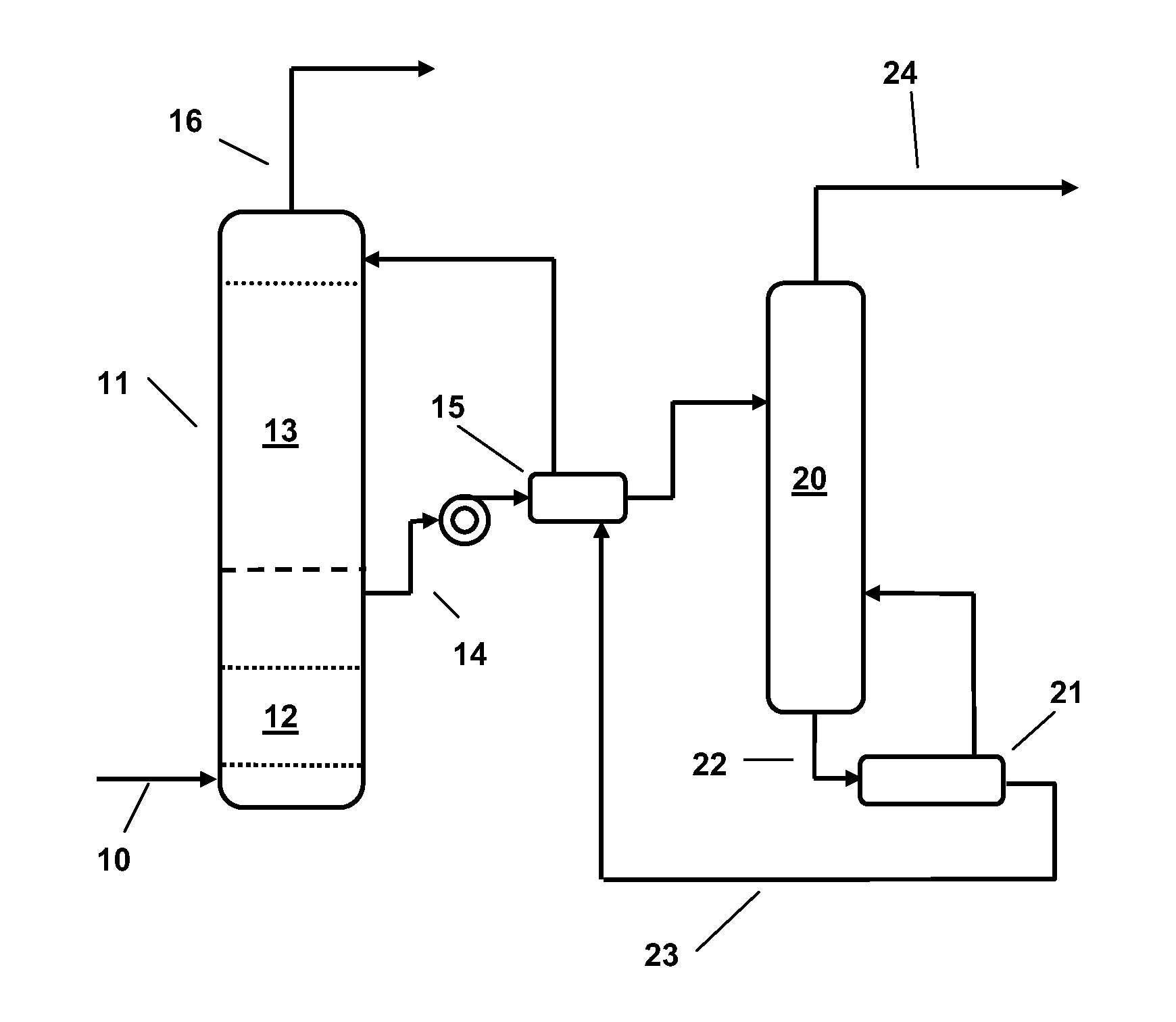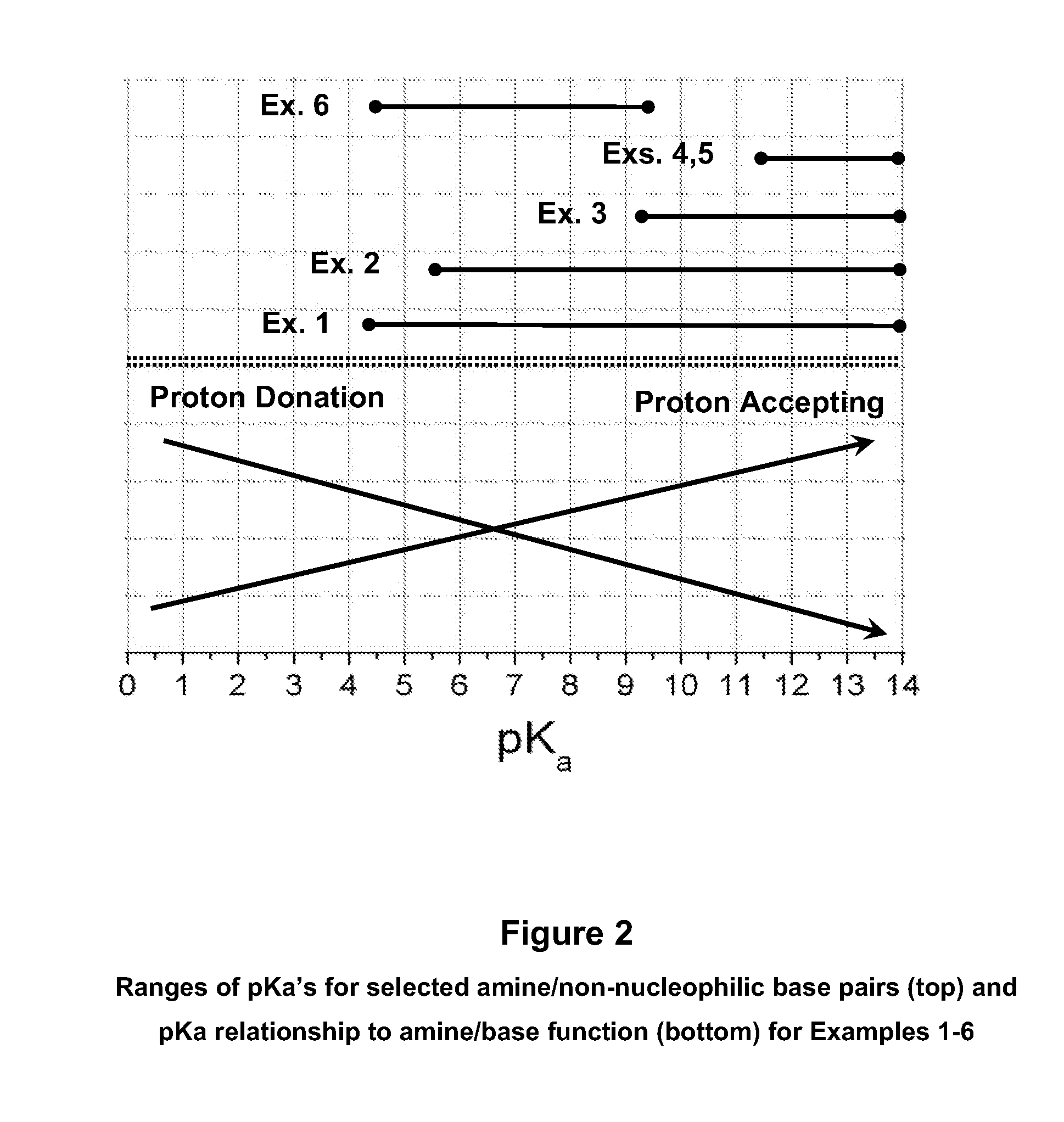Mixed Amine and Non-Nucleophilic Base CO2 Scrubbing Process for Improved Adsorption at Increased Temperatures
a technology of amine and non-nucleophilic base, which is applied in the direction of separation process, dispersed particle separation, chemistry apparatus and processes, etc., can solve the problems of corrosive nature of amine, high gas requirement, and high energy requirement for the regeneration of amine solutions, so as to reduce process operating costs, reduce temperature and pressure stability, and avoid substantial viscosity increase and/or phase separation
- Summary
- Abstract
- Description
- Claims
- Application Information
AI Technical Summary
Benefits of technology
Problems solved by technology
Method used
Image
Examples
example 1
Mixed Carbamate Formation with Aniline / 1,1,3,3-tetramethylguanidine
[0090]An approximately 26.7 wt % solution of a ˜1:1 molar mixture of aniline (pKa˜4.6) and tetramethylguanidine (TMG) was prepared in d6-DMSO in a ˜10 mm NMR tube fitted with a plastic cap and capillary dip tube. The NMR tube was placed inside a ˜10 mm wide-bore Bruker Avance 400 MHz NMR spectrometer with a BBO probe. CO2 (˜1 atm, or ˜100 kPa partial pressure, and at ˜3-5 cc / min flow, as measured by a Brooks 5896™ flow controller) was bubbled through the room temperature (˜20-25° C.) solution for approximately 3 hours (until no further CO2 uptake was observed by NMR). The initial spectra of the starting materials changed upon CO2 addition and indicated the formation of one product only (mixed carbamate C═0 resonance at ˜158.6 ppm). The protonation of the guanidine to guanidinium appeared to be confirmed by the shift of the C═N resonance at ˜166.4 ppm upfield to ˜161.8 ppm (in relatively fast equilibrium with any rema...
example 1.1
Mixed Carbamate with Aniline / TMG and H2O
[0095]Tetramethylguanidine was observed to form a very stable bicarbonate species with CO2 in aqueous solution. In order to probe the competitive reaction between tetramethylguanidine, aniline, and H2O, an approximately 28 wt % solution of a ˜1:1 molar mixture of H2O and tetramethylguanidine was prepared in aniline / water solution (˜1:˜1:˜3.9 molar ratio of H2O, tetramethylguanidine, and aniline). Theoretically, tetramethylguanidine should be able to form 100 mol % bicarbonate with H2O. Using a procedure similar to that described above, the appearance of intermediate and equilibrium reaction products was monitored by NMR for ˜13 hours. During CO2 flow, the tetramethylguanidine peak appeared to move upfield and aniline peaks appeared to split, indicating reaction between these two compounds. The 13C NMR spectrum at equilibrium had two new peaks at ˜160.66 ppm (tetramethylguanidine bicarbonate C═O) and ˜159.65 ppm (tetramethylguanidine / aniline ca...
example 2
Mixed Carbamate Formation with 3,3-Iminodipropionitrile / TMG
[0097]An approximately 29.7 wt % solution of a ˜1:1 molar mixture of 3,3′-iminodipropionitrile (pKa˜5.26) and tetramethylguanidine was prepared in d6-DMSO in a ˜10 mm NMR tube fitted with a plastic cap and capillary dip tube. The NMR tube was placed inside a ˜10 mm wide-bore Bruker Avance 400 MHz NMR spectrometer with a BBO probe. 13C and 1H spectra were taken. CO2 (˜1 am, or ˜100 kPa, and 99.98% purity) was bubbled (˜5.5 cc / min, as measured by a Brooks 5896 flow controller) through the room temperature (˜20-25° C.) solution, simultaneously recording 13C and 1H spectra for approximately 2 hours (until no further changes in NMR spectra were observed). The initial spectra of the starting materials appeared to change upon CO2 addition. New 13C and 1H peaks were formed at ˜159.85 ppm and ˜8.76 ppm, respectively, believed to indicate mixed carbamate formation between the iminodipropionitrile and tetramethylguanidine. ˜100 mol % o...
PUM
| Property | Measurement | Unit |
|---|---|---|
| Temperature | aaaaa | aaaaa |
| Temperature | aaaaa | aaaaa |
| Temperature | aaaaa | aaaaa |
Abstract
Description
Claims
Application Information
 Login to View More
Login to View More - R&D
- Intellectual Property
- Life Sciences
- Materials
- Tech Scout
- Unparalleled Data Quality
- Higher Quality Content
- 60% Fewer Hallucinations
Browse by: Latest US Patents, China's latest patents, Technical Efficacy Thesaurus, Application Domain, Technology Topic, Popular Technical Reports.
© 2025 PatSnap. All rights reserved.Legal|Privacy policy|Modern Slavery Act Transparency Statement|Sitemap|About US| Contact US: help@patsnap.com



